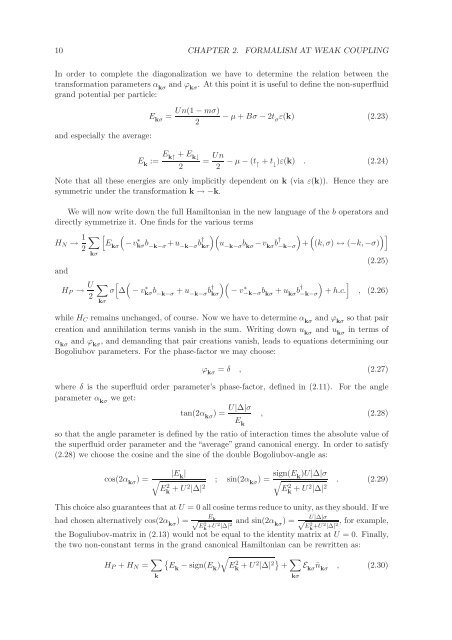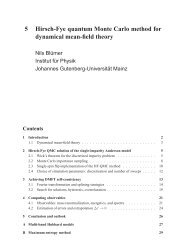Hubbard Model for Asymmetric Ultracold Fermionic ... - KOMET 337
Hubbard Model for Asymmetric Ultracold Fermionic ... - KOMET 337
Hubbard Model for Asymmetric Ultracold Fermionic ... - KOMET 337
Create successful ePaper yourself
Turn your PDF publications into a flip-book with our unique Google optimized e-Paper software.
10 CHAPTER 2. FORMALISM AT WEAK COUPLINGIn order to complete the diagonalization we have to determine the relation between thetrans<strong>for</strong>mation parameters α kσand ϕ kσ. At this point it is useful to define the non-superfluidgrand potential per particle:and especially the average:E kσ=Un(1 − mσ)2− µ + Bσ − 2t σε(k) (2.23)E k:= E k↑ + E k↓2= Un2 − µ − (t ↑ + t ↓)ε(k) . (2.24)Note that all these energies are only implicitly dependent on k (via ε(k)). Hence they aresymmetric under the trans<strong>for</strong>mation k → −k.We will now write down the full Hamiltonian in the new language of the b operators anddirectly symmetrize it. One finds <strong>for</strong> the various termsH N → 1 ∑ ()() ()][E2 kσ−vkσ ∗ b −k−σ +u −k−σ b† kσu −k−σb kσ−v kσb † −k−σ+ (k,σ) ↔ (−k, −σ)andH P → U 2kσ∑kσ[ ()() ]σ ∆ − vkσ ∗ b −k−σ + u −k−σ b† kσ− v−k−σ ∗ b kσ + u kσ b† −k−σ+ h.c.(2.25), (2.26)while H C remains unchanged, of course. Now we have to determine α kσand ϕ kσso that paircreation and annihilation terms vanish in the sum. Writing down u kσand u kσin terms ofα kσand ϕ kσ, and demanding that pair creations vanish, leads to equations determining ourBogoliubov parameters. For the phase-factor we may choose:ϕ kσ= δ , (2.27)where δ is the superfluid order parameter’s phase-factor, defined in (2.11). For the angleparameter α kσwe get:tan(2α kσ) = U|∆|σE k, (2.28)so that the angle parameter is defined by the ratio of interaction times the absolute value ofthe superfluid order parameter and the “average” grand canonical energy. In order to satisfy(2.28) we choose the cosine and the sine of the double Bogoliubov-angle as:cos(2α kσ) =|E k|√ ; sin(2α kσ) = sign(E k )U|∆|σ . (2.29)Ek 2 + U2 |∆|√E 2 k 2 + U2 |∆| 2This choice also guarantees that at U = 0 all cosine terms reduce to unity, as they should. If weEhad chosen alternatively cos(2α kσ) = √ kand sin(2α E 2k +U 2 |∆| 2 kσ ) = U|∆|σ√E 2k +U 2 |∆| 2, <strong>for</strong> example,the Boguliubov-matrix in (2.13) would not be equal to the identity matrix at U = 0. Finally,the two non-constant terms in the grand canonical Hamiltonian can be rewritten as:H P + H N = ∑ k{Ek − sign(E k)√E 2 k + U2 |∆| 2} + ∑ kσE kσ¯n kσ, (2.30)













